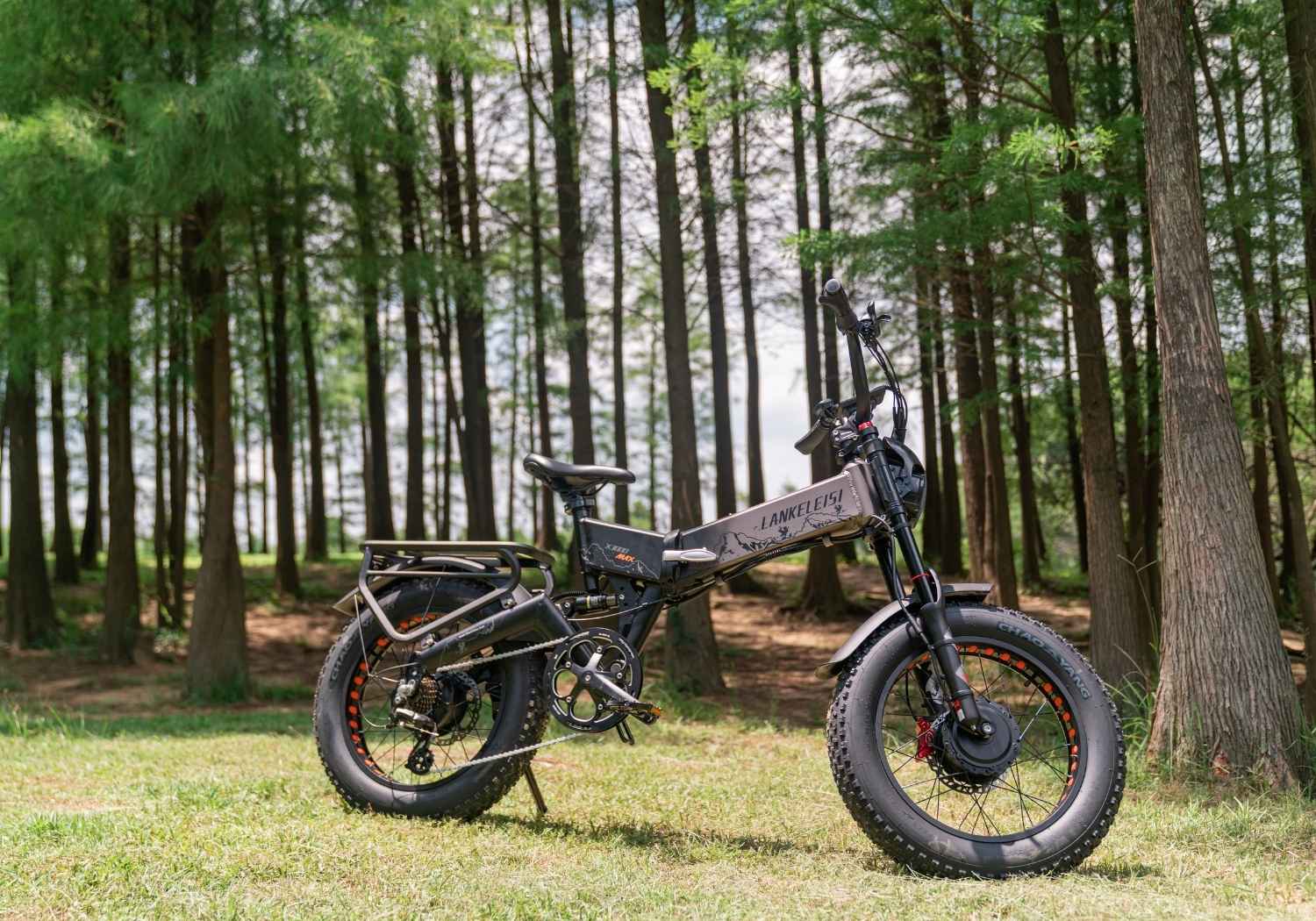Do you want to know the real lifespan of an e-bike battery? Whether you're considering buying your first e-bike or already own one, understanding battery life is essential to getting the most out of your investment. After all, the battery is one of the most important—and expensive—components of an e-bike.
Today, more and more people are using electric bikes as a means of transportation for urban commuting, exercise, or adventure. Therefore, battery care and maintenance are essential.
In this article, you will discover all the useful information about the lifespan of electric bike batteries, to help you extend their longevity as much as possible.
Understanding Electric Bike Batteries
Before diving deeper intoe-bike battery life, it's essential to understand how they work and the differences between them. Not all e-bike batteries are created equal, and knowing the basics will help you make more informed decisions when purchasing, using, and maintaining them.
What are the main types of batteries for electric bikes?
Most modern e-bikes use lithium-ion batteries, similar to those used in smartphones and electric cars. These batteries are lightweight, have a high energy density, and can withstand hundreds of charge cycles.
Older or cheaper models may use lead-acid or nickel-based batteries, but these are generally heavier, less efficient, and have a shorter lifespan.
Built-in battery vs removable battery
Some electric bikes have removable batteries , which are easy to remove and recharge, while others integrate the battery directly into the frame for a sleeker design.
Recommended reading: Should you remove the battery on an electric bike?
Built-in batteries generally offer better protection, but can be more complicated to replace.
In terms of lifespan, what matters most is the quality of the battery, not its location—although removable batteries are often easier to store in optimal conditions (cool, dry place).

What is a high quality battery?
The reliability of an electric bike battery depends not only on its technical characteristics, but also on the quality of the cells, the battery management system (BMS) and the reputation of the brand.
Cells produced by well-known brands such as Samsung, LG, and Panasonic are durable and offer stable performance. The BMS is also crucial, as it regulates charging, discharging, and thermal management, thus protecting the battery from damage and helping to extend its lifespan.
When choosing an electric bike, never neglect the battery brand and specifications. A high-quality battery is not only safer, but also guarantees greater range, faster charging, and a longer lifespan.
Average lifespan of electric bike batteries
On average, a high-quality lithium-ion battery has a lifespan of 3 to 5 years, or approximately 500 to 1,000 complete charge cycles.
This means that if you use your e-bike regularly, you will likely start to notice a decrease in performance or range after a few years, depending on how well you maintain the battery.
Key Factors Influencing Electric Bike Battery Life
The lifespan of an e-bike battery is not fixed; it depends on several internal and external factors. To get the most out of your investment, it's essential to understand what factors affect the battery's long-term performance. Here are the main factors that influence the lifespan of e-bike batteries.
Battery type and manufacturing quality
Not all batteries are created equal. Lithium-ion batteries, known for their high energy density and long lifespan, have become the industry standard. However, even within this category, quality varies.
High-end batteries made by reliable brands like Samsung, LG, and Panasonic generally offer better performance than standard batteries. A well-designed battery management system (BMS) also plays a crucial role, regulating charge and discharge rates and preventing overheating.
Battery capacity
Higher-capacity batteries (measured in amp-hours or watt-hours) not only offer greater range, but also longer battery life. They are less likely to be completely discharged during an outing, reducing the frequency of deep discharges and therefore long-term wear.

Usage habits
The frequency and distance of your journeys directly affect battery life. Frequent use with high assistance or at high speeds puts more strain on the battery. Using only throttle mode, carrying heavy loads, or climbing steep hills also increases consumption, reducing battery life.
Driving conditions
Rough terrain places greater demands on the battery. Off-road trails, constant elevation changes, headwinds, and uneven surfaces increase energy demand and accelerate battery wear. On the other hand, steady, consistent driving in moderate conditions is generally more beneficial.
Temperature and climate
Temperature is crucial to battery health. Extremely high temperatures reduce the performance of lithium-ion batteries, while cold temperatures can temporarily impair them. Ideally, the battery should be used and stored between 10°C and 25°C (50°F and 77°F). Driving or charging the battery in extreme weather can shorten its lifespan.
Proper storage
If you plan not to use your e-bike for several weeks or months (e.g., during winter), avoid leaving the battery fully charged or completely discharged. Store it in a cool, dry place with a charge between 50% and 70%. Always remove the battery from the bike to prevent phantom discharge and protect the electronic components.
Charging behavior
Frequent overcharging or deep discharging will significantly reduce battery life. In daily use, it is best to keep the charge between 20% and 80%.
Always use the original bicycle charger recommended by the manufacturer, avoid leaving the battery charging overnight and unplug the charger once the battery is fully charged.
Maintenance and upkeep
Regular maintenance is essential. Keep the battery terminals clean and dry, avoid unnecessary shock or vibration, and regularly inspect the battery for physical damage. Some high-end models also offer software updates or diagnostic features that can monitor battery health.
Understanding and optimizing these factors can significantly extend the life of your e-bike battery, sometimes by several years. By adopting smart practices for use, charging, and storage, you'll not only save money but also enjoy a more reliable and efficient riding experience.
What is the battery life of LANKELEISI electric bikes?
LANKELEISI e-bike batteries typically have a lifespan of 3 to 5 years under normal use, which corresponds to approximately 800 to 1,000 complete charge cycles. With careful maintenance and under optimal usage conditions, their lifespan can even exceed this range.
Most high-end LANKELEISI models are equipped with high-quality lithium-ion cells from reliable brands like Samsung. These cells are renowned for their durability, high energy density, and ability to retain good capacity after several hundred cycles. For example:
The LANKELEISI X3000 MAX is equipped with a Samsung 48V 20Ah lithium-ion battery made up of 21700 cells. Its high capacity of 960Wh allows a range of up to 70 km in all-electric mode and up to 130 km in assistance mode.

The LANKELEISI MG800Mmax also uses 21700 cells in a Samsung 48V 20Ah battery, with a battery management system (BMS) ensuring safety. It offers a range of 55 km in all-electric mode and up to 130 km in assist mode.
The LANKELEISI GOFL-X is equipped with an advanced Samsung 48V 20Ah battery, with 21700 cells. Its range is 60 to 70 km in all-electric mode, and 120 to 150 km in assistance mode.

Thanks to its advanced Battery Management System (BMS), the LANKELEISI battery is protected against overcharging, overheating, and deep discharge. In addition, LANKELEISI batteries have an IP54 protection rating, guaranteeing good waterproofing against splashes, ensuring safe use in all circumstances. All these elements contribute to extending the battery's lifespan.
Signs of aging in an electric bike battery
Even the best e-bike batteries don't last forever.
Over time, you'll begin to notice subtle (or sometimes more obvious) changes in battery performance, indicating that its lifespan is nearing the end.
Identifying these signs early allows you to act before complete battery failure, avoiding sudden outages and potentially dangerous situations.
Reduction of autonomy
One of the most obvious signs of aging is a noticeable decrease in range. If you used to be able to travel 60 km on a full charge, but now you can't even reach 30 km under similar conditions, it probably means your battery's capacity is decreasing.
This degradation occurs as the internal battery wears out after several hundred charge cycles.
Extended charging time
The charging time of a healthy battery remains relatively stable. If you notice that your battery is taking much longer to charge than before, or that it is no longer fully charging, this may indicate a decrease in its storage efficiency.
Unstable power output
Have you ever experienced unexpected power outages, slow response to pedal assist, or harsh acceleration? These abnormalities may indicate that the battery is struggling to provide stable voltage, often due to cell degradation or a malfunctioning battery management system (BMS).
Battery overheating
Slight heating during use or charging is normal, but overheating is a warning sign.
If your battery becomes unusually hot, especially during charging or under heavy load, this may indicate an internal fault. Overheating not only reduces battery life, but can also pose safety risks.
Physical damage or swelling
Visually inspect your battery regularly. Swelling, bulging, leaking, or corrosion around the connectors are serious signs of internal damage.
If you observe any of these phenomena, immediately stop using the battery and consult a professional for replacement or safe disposal.
Tips to Extend Your Electric Bike Battery Life
Extending your e-bike's battery life isn't difficult, but it does require consistency. Follow the expert tips below to help your battery run longer and more efficiently:
- Avoid deep discharge and overcharging : On a daily basis, keep the battery charge level between 20% and 80%. Avoid completely discharging the battery or leaving it plugged in once fully charged to reduce wear on lithium-ion batteries.
- Charge at moderate temperatures : Only charge the battery in a cool, dry environment (ideal temperature between 10°C and 25°C). After a ride, avoid charging the battery while it is still hot.
- Use a suitable charger : if you have a LANKELEISI electric bike, you must use the original LANKELEISI charger .
- Maintain a partial charge level during periods of inactivity : If you will not be using your e-bike for several weeks, store the battery in a dry place with a charge of approximately 50 to 70%, avoiding direct exposure to sunlight or extreme temperatures.
- Avoid exposure to heat, cold, and humidity : High temperatures and freezing temperatures will reduce battery life. Never leave your e-bike in a very hot car or in freezing weather for extended periods.
- Perform an occasional full charge : Every 1 to 2 months, fully discharge the battery and then recharge it to 100% to help calibrate the Battery Management System (BMS).
- Check and clean the battery regularly : Wipe the connectors with a dry cloth and check them for dirt, moisture, and corrosion. Clean connections ensure safe and efficient power transmission.
FAQ about electric bike battery life
Can I upgrade to a larger capacity battery?
Yes, in many cases it is possible to upgrade to a larger capacity battery to increase range. However, compatibility is key. Make sure the new battery matches your bike's voltage, controller settings, and mounting system. For example, LANKELEISI offers pre-configured large capacity batteries of 17.5 Ah and 20 Ah, ideal for long distances.
What is the best way to store an electric bike battery in winter?
It is recommended to keep the battery charged between 50% and 70% and store it in a cool, dry place. Never leave the battery fully charged or completely discharged for several weeks or months.
Can the battery be left charging overnight?
Occasional overnight charging is generally safe, especially for batteries equipped with a battery management system (BMS). However, to maximize battery life, it is best to disconnect the charger once the battery is at 100%. Prolonged continuous charging can cause overheating and reduce battery life.
Recommended Reading: How Long Does It Take to Charge an Electric Bike Battery
How to safely recycle or dispose of a used battery?
Never throw an e-bike battery in the trash. They contain lithium and other hazardous substances. Take them to an authorized recycling center or an electronic waste collection point near you.
Conclusion
From understanding battery types and usage habits to learning proper maintenance practices, proper care undoubtedly extends battery life and improves overall bike performance.
If you are looking for an electric bike that combines long range, quality components and excellent value for money, LANKELEISI electric bikes are the ideal choice.








